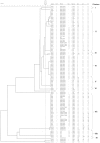Molecular epidemiology of Campylobacter isolates from poultry production units in southern Ireland
- PMID: 22163024
- PMCID: PMC3232229
- DOI: 10.1371/journal.pone.0028490
Molecular epidemiology of Campylobacter isolates from poultry production units in southern Ireland
Abstract
This study aimed to identify the sources and routes of transmission of Campylobacter in intensively reared poultry farms in the Republic of Ireland. Breeder flocks and their corresponding broilers housed in three growing facilities were screened for the presence of Campylobacter species from November 2006 through September 2007. All breeder flocks tested positive for Campylobacter species (with C. jejuni and C. coli being identified). Similarly, all broiler flocks also tested positive for Campylobacter by the end of the rearing period. Faecal and environmental samples were analyzed at regular intervals throughout the rearing period of each broiler flock. Campylobacter was not detected in the disinfected house, or in one-day old broiler chicks. Campylobacter jejuni was isolated from environmental samples including air, water puddles, adjacent broiler flocks and soil. A representative subset of isolates from each farm was selected for further characterization using flaA-SVR sub-typing and multi-locus sequence typing (MLST) to determine if same-species isolates from different sources were indistinguishable or not. Results obtained suggest that no evidence of vertical transmission existed and that adequate cleaning/disinfection of broiler houses contributed to the prevention of carryover and cross-contamination. Nonetheless, the environment appears to be a potential source of Campylobacter. The population structure of Campylobacter isolates from broiler farms in Southern Ireland was diverse and weakly clonal.
Conflict of interest statement
Figures







References
-
- EFSA. The European Union Summary Report on Trends and Sources of Zoonoses, Zoonotic Agents and Food-borne Outbreaks in 2009. EFSA Journal 2011. 2011;9(3):2090. [378pp.] doi:10.2903/j.efsa.2011.2090. Available online: www.efsa.europa.eu/efsajournal [last accessed 02/07/2011]
-
- EFSA. EFSA Panel on Biological Hazards (BIOHAZ); Scientific Opinion on Quantification of the risk posed by broiler meat to human campylobacteriosis in the EU. EFSA Journal 2010. 2010;8(1):1437. [89 pp.]. doi:10.2903/j.efsa.2010.1437. Available online: www.efsa.europa.eu [last accessed 02/07/2011]
-
- EFSA. Analysis of the baseline survey on the prevalence of Campylobacter in broiler batches and of Campylobacter and Salmonella on broiler carcasses in the EU, 2008 Part A: Campylobacter and Salmonella prevalence estimates. EFSA Journal 2010. 2010;8(03):1503. [99 pp.]. doi:10.2903/j.efsa.2010.1503. Available online: www.efsa.europa.eu [last accessed 02/07/2011]
-
- ACMSF. The Advisory Committee on the Microbiological Safety of Food. 2005. Second report on Campylobacter. - PubMed
-
- Buhr RJ, Musgrove MT, Richardson LJ, Cox NA, Wilson JL, et al. Recovery of Campylobacter jejuni in feces and semen of caged broiler breeder roosters following three routes of inoculation. Avian Dis. 2005;49:577–581. - PubMed
Publication types
MeSH terms
LinkOut - more resources
Full Text Sources

